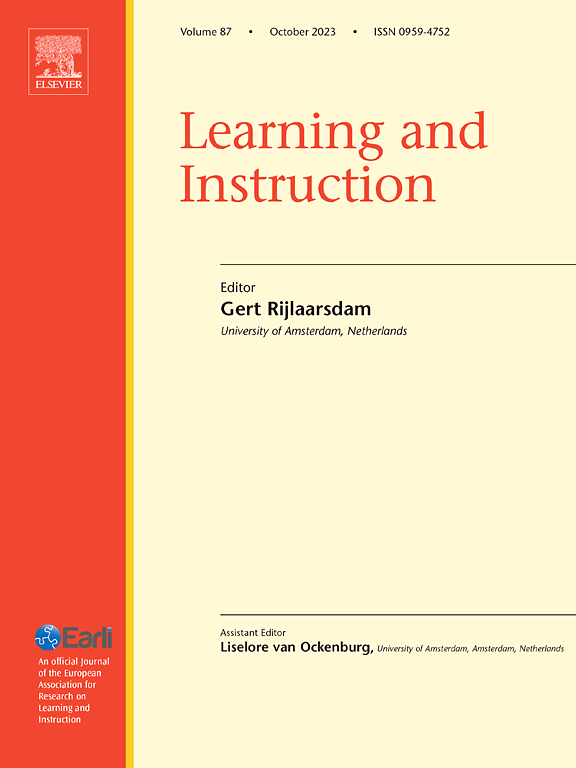一个红色按钮完成了一切:一个红色按钮在智能辅导系统中推动学生缩小他们的知识差距
IF 4.9
1区 教育学
Q1 EDUCATION & EDUCATIONAL RESEARCH
引用次数: 0
摘要
智能辅导系统(ITSs)通常自适应地为学生提供额外的学习材料,以弥补系统自动识别的知识差距。此外,学生可能会被提醒徽章推动,以缩小他们的知识差距。目的本研究评估了一个提醒徽章(红色小按钮)的实施效果,提醒学生关闭他们的知识差距。在控制其他相关因素(例如,使用行为、系统特性和教师的作业类型)的同时,我们还调查了缩小知识差距和绩效之间的关系。样本:我们考虑了105081名学生(6668个班级,处理2500万个问题)使用ITS学习数学。方法我们采用层次线性回归分析来评估在ITS中实施通知徽章的时期,与没有通知徽章的时期相比,学生是否更有可能缩小他们的知识差距。此外,我们使用心理网络分析和层次线性回归分析来评估相对于其他相关因素,知识差距的缩小是否与学生的表现相关。结果当红色按钮提示时,学生弥补了28%的知识空白,而当没有红色按钮提示时,这一比例仅为5%。缩小知识差距预示着更好的学生表现,比学生的使用行为、其他系统功能和教师的作业类型更重要。我们的研究强调了智能交通系统内的推动与缩小知识差距的相关性,并表明缩小知识差距与学生的表现有关。本文章由计算机程序翻译,如有差异,请以英文原文为准。
A red button does it all: A red button nudges students to close their knowledge gaps in an intelligent tutoring system
Background
Intelligent tutoring systems (ITSs) often adaptively provide students with additional learning materials to close knowledge gaps automatically recognized by the system. In addition, students may be nudged with notification badges to close their knowledge gaps.
Aim
This study evaluated the effectiveness of implementing a notification badge (small red button) reminding students to close their knowledge gaps. We also investigated the association between closing knowledge gaps and performance while controlling for other relevant factors (e.g., usage behavior, system features, and teachers’ assignment types).
Sample
We considered 105,081 students (in 6,668 classes working on ∼25 million problems) who used an ITS for learning mathematics.
Methods
We employed hierarchical linear regression analysis to evaluate whether students were more likely to close their knowledge gaps in a period in which notification badges were implemented in the ITS, as compared to a period without notification badges. Moreover, we used psychological network analysis and hierarchical linear regression analysis to evaluate whether closing knowledge gaps was associated with students’ performance relative to other relevant factors.
Results
Students closed 28 % of their knowledge gaps when the red button notification badge nudged them, but only 5 % when there was no red button. Closing knowledge gaps predicted better student performance and was a more important predictor than students' usage behavior, other system features, and teachers’ assignment types.
Conclusions
Our study highlights the relevance of nudges within ITS for closing knowledge gaps and shows that closing knowledge gaps is linked to students’ performance.
求助全文
通过发布文献求助,成功后即可免费获取论文全文。
去求助
来源期刊

Learning and Instruction
Multiple-
CiteScore
11.30
自引率
4.80%
发文量
109
期刊介绍:
As an international, multi-disciplinary, peer-refereed journal, Learning and Instruction provides a platform for the publication of the most advanced scientific research in the areas of learning, development, instruction and teaching. The journal welcomes original empirical investigations. The papers may represent a variety of theoretical perspectives and different methodological approaches. They may refer to any age level, from infants to adults and to a diversity of learning and instructional settings, from laboratory experiments to field studies. The major criteria in the review and the selection process concern the significance of the contribution to the area of learning and instruction, and the rigor of the study.
 求助内容:
求助内容: 应助结果提醒方式:
应助结果提醒方式:


